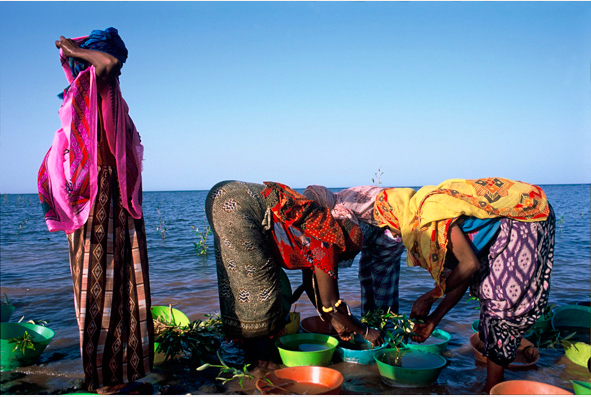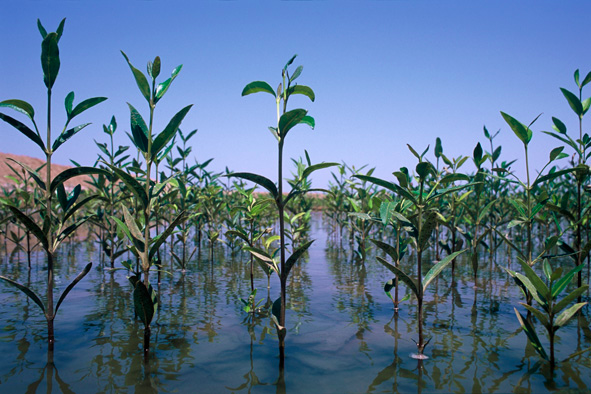Overview
The object of the Manzanar Mangrove Initiative is to create whole new forests of mangrove trees in vast areas of the world where mangrove trees do not grow at the present time. This will contribute to alleviating poverty in different parts of the world and to diminishing the threat of global warming. Poverty would be alleviated by creating a renewable resource – mangrove trees, which produce valuable timber–and by enriching the fish populations of adjacent seas. The mangrove forests would fix CO2 by photosynthesis and thus decrease the possibility of a catastrophic series of events – global warming by atmospheric CO2, melting of the polar ice caps, and inundation of the great coastal cities of the world. Eritrea was chosen as the site for the project demonstration for several reasons–most importantly, the indigenous population regularly faces famine due to the impossibility of developing an agrarian economy in a desert area.
Quick Facts
Project Location:
Massawa, Eritrea, 15.607875, 39.455383900000015
Geographic Region:
Africa
Country or Territory:
Eritrea
Biome:
Coastal/Marine
Ecosystem:
Estuaries, Marshes & Mangroves
Project Lead:
Gordon Sato
Organization Type:
Other
Location
Project Stage:
Implementation
Start Date:
1988-01-01
End Date:
1988-01-01
Primary Causes of Degradation
Fisheries & AquacultureDegradation Description
The coastal ecosystem of Eritrea is being altered by mangrove afforestation and the introduction of aquaculture technology as a means of improving the socio-economic circumstances of impoverished local communities.
Reference Ecosystem Description
Eritrea has over 620 miles of coast, and most of it is gradually sloping beaches and shallow bays with thickets of mangroves forming a 100-meter fringe along the water’s edge. These mangrove stands comprise fifteen percent of the intertidal zone in Eritrea, and they are found in mersas, or creek mouths along the arid coastline where seasonal rains collect for just a few days of the year and flow into the sea. These mersas carry large amounts of sediment from inland areas and bring vital nutrients, namely nitrogen, phosphorus, and iron, that create ideal growing conditions for mangroves.
The Eritrean coast, with its shallow bays and mangrove clusters, is the perfect environment for fish farming. Here in the shallow water, fish, crabs, and shrimp live and breed thanks to the plankton, algae, and organisms that grow among the mangrove roots. Mullet, milkfish, sea bream, and red snapper all thrive here. Somewhat more than 500 yards offshore, thousands of acres of coral reef offer shelter to grouper, emperor, and many other species. Water quality in this area is without pollutants, and temperatures that range between 77 and 80 degrees Fahrenheit throughout the eight month fish maturation period are ideal for maximizing production.
The harbour town of Massawa, where the Manzanar project is based, is one of the driest places on Earth, with an annual rainfall of less than 20mm. This lack of precipitation, combined with temperatures up to 131 degrees Fahrenheit during the June through September period, facilitate the use and maintenance of aquaculture ponds, as they provide an opportunity for draining and drying the ponds in preparation for the next production cycle.
Project Goals
To increase Eritrea’s per capita GDP tenfold to 1500 USD per year.
To alleviate poverty and help counter deforestation and global warming by creating whole new forests of mangrove trees in vast areas of the world where mangrove trees do not grow at the present time.
Monitoring
The project does not have a monitoring plan.
Stakeholders
Eritrea, which won independence from Ethiopia in 1993, is one of the world’s poorest countries, with an annual per-capita income of only $A280. The lands which lie along its 1000km coastline are especially poor. Through the planting of mangroves, this project aims to create an economic base for coastal communities and improve their standard of living.
Description of Project Activities:
The process is very simple. Artificial mangrove swamps are created by digging large areas to the depth of one foot below the average high tide level. Mangroves, which grow into five foot tall bushy shrubs in about six months, are planted using the fruit and propagules. After the trees are established, they drop leaves, which serve as food for nitrogen fixing bacteria, so that the forest can perpetuate itself. The decomposing leaves also provide nourishment for the large numbers of fish, shrimp and crab that seek shelter in the mangrove roots.
Next to the mangrove swamps, deeper ponds are dug which are fertilized with a mixture of camel and goat dung. The algae that grow in this environment support mullet, a fish that is related to the algae-mud eating carp. These fish grow from the fingerling stage to one pound in four months, and then they are caught, cleaned, and shipped to the highlands. The viscera and heads are used to feed crab, shrimp and carnivorous fish that are cultured in other ponds or in cages anchored off shore.
The team is using the native African mangrove Avicennia marina, which provides excellent fodder for camels and goats. It is also planting out a second native mangrove species, Rhizophora mucronata, which had become almost extinct in the region because of its value as building timber. This species is also used for firewood - vital in a country where three-quarters of household energy comes from burning wood.
The basic assumption of the Manzanar project is that the vast deserts, readily available seawater, and abundant sunshine can be utilized to grow plants that can be irrigated with seawater to create wealth. That being said, we know that providing drainage for mangroves planted away from the sea will be our major concern. We also know that we will have to provide a slow-release fertilizer in order to successfully establish trees away from the nutrient-rich mersas.
Ecological Outcomes Achieved
Eliminate existing threats to the ecosystem:
During the course of our work we planted mangroves around the periphery of ponds to stabilize banks and at sites well above sea level where the trees are irrigated with sea water. We noted that in almost all cases the trees grew as well as in their natural habitat. In fact, many of the mangrove trees are now well above head height, and the yellow-green coats of ripe propagules are beginning to split open, showing the plump green leaves within. The mangrove mud is sprouting pneumatophores, as if someone had sown a crop of pencils. Barnacles and oysters have started to settle on them, and crab and winkle trails crisscross the sediment.
In 2001, workers on the Manzanar project grew about 60,000 mangrove seedlings at various nurseries near Massawa, later successfully replanting them near the coast. The following year, the local Eritrean community planted another 250,000 mangroves, mostly at the village of Hargigo, 10km south of Massawa. In 2004 the total plantings at Manzanar exceeded 600,000 trees. It is estimated that the Manzanar Project has planted nearly one million mangrove trees on the coast of Eritrea since the project began.
Socio-Economic & Community Outcomes Achieved
Economic vitality and local livelihoods:
The Manzanar project has now grown enough mangroves on the coast near Massawa to feed 2000 people with the animals the trees support. The project has planted about 600,000 mangrove trees in the vicinity of the village of Hargigo alone, and families in the village are raising sheep and goats on a diet of exclusively mangrove material. As a bonus, a great many crabs, shrimps and baby fish are now appearing in the mangrove plantation, helping to restore the local fishery. Sato believes that the mangrove forests will eliminate hunger and poverty in the village of Hargigo.
Long-Term Management
The main objective of the Manzanar project is to train people who have the confidence to think independently and try new things to build their country. It is important that they have a hands-on working knowledge of the project. Cleanliness will also be emphasized in the Manzanar project. Cleanliness means that people pay attention to the details of work and do it well.
Sources and Amounts of Funding
500,000 USD Dr. Gordon Sato; the government of Eritrea
Other Resources
The Manzanar Project
http://www.tamu.edu/ccbn/dewitt/manzanar/default.htm
Samuel Negassi
P.O. Box 3253
Asmara, Eritrea
Telefax: 011-291-1-552-971
[email protected]
Dr. Gordon Sato
27 Cedar St.
Wenham MA 01984
Tel 978 468 6005
Fax 978 468 0541
[email protected]




